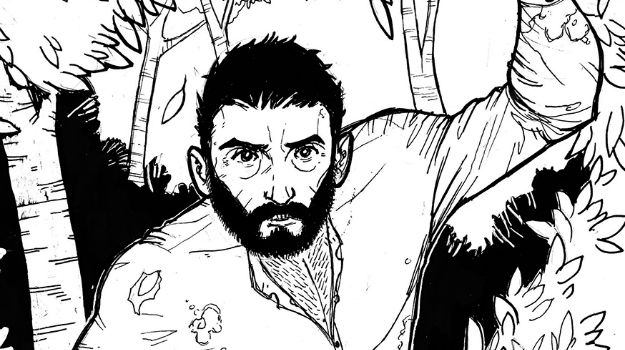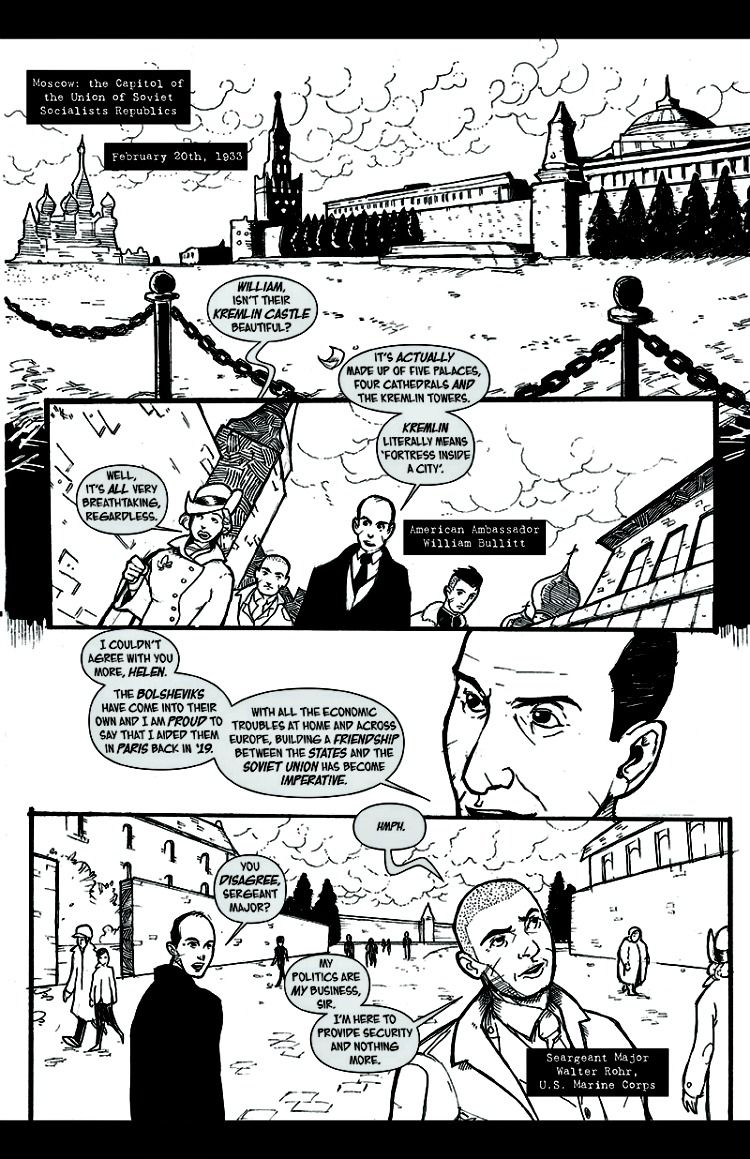I consider myself fairly well-versed in large-scale atrocities. So I was surprised to discover I was unaware of 1933's Nazino affair until last week, when writer Steve Ekstrom launched his webcomic Cannibal Island.
To learn more about his new collaboration with artist Dionysios, I reached out to him with a few questions. The webcomic gave readers seven pages last week and will return with new installments on Oct. 15, 22 and 29 (along with a bonus surprise on Oct. 31).
Tim O'Shea: What prompted your interest in doing a story inspired by 1933's Nazino affair?
Steve Ekstrom: Honestly, I was kind of looking for inspiration. I'd been wanting to start an outline for a noir-ish suspense story set in a prison camp during World War II.
What happened? I spent most of my night clicking my way through the back alleys of the Internet (the non-adult ones, anyway), and I found myself on a "zombie conspiracy theory" website. It had this creepy Google Map that indicated that there were parts of the map that were still not viewable at the time (around 2008), so I started reading about strange events. Lo and behold, Nazino is one of the largest recorded acts of cannibalism in modern history.
I was totally engrossed with the tragedy of the situation. Because the event wasn't uncovered until the late '80s/early '90s by French historian Nicolas Werth, there wasn't a lot of data about the real-time occurrence of the event itself -- just historical accounts from research he had done.
So I just saw this huge opportunity for a very cool, socially relevant story that might scare the pants off of all us, me included.
How much research was required to get the characters and story setting just right?
I tend to develop a plotline first. For now, I still kind of cling to character archetypes because I want to create palatable projects that are easy for a reader to digest.
Walter Rohr is actually an homage to my friend Chip Rohr from high school. Walter has a large scar on his throat from a bayonet wound he received during World War I. Chip has been fighting esophageal cancer for a couple of years now. I wanted to pay tribute to his strength by making my tough-as-nails lead character a symbolic fictional tribute to him.
As for research, I did enough topical research to make sure that I stayed within a boundary of the actual history of the event. Meaning: if it happened in the actual history, I wanted it to ring true in the fiction. There are a lot of ways to engage a historical event like the Nazino affair without straying too far outside of the lines of reality all the while still creating a unique piece of fiction.
The only real text out there is Werth's book, Cannibal Island: Death in a Siberian Gulag, so that's been my template for the whole project. As the story unfolds, Dionysios and I will be referencing a lot of the anecdotes from the historical record.
Did you consider calling the series Death Island, or was it always going to be Cannibal Island?
"Death Island" is what the Russians actually call Nazino. As much as I like that name, "Cannibal Island" is much direct and I want to immediately create a mystique for the project that takes the reader and says, "Something bad is coming."
"Cannibal Island" bares no bones about the portents of the story. Also, I liked incorporating Russian symbols into the iconography of both the logo of the project and the website for the webcomic. There's a really easy to spot "Easter egg" on the front page of the site. If you look for a second and know a bit of global trivia ... you'll spot it right away.
What motivated you to tap Dionysios for this project?
Dionysios and I were local to each other until about a month ago. We have this crazy back story because, essentially, we were set up on a "blind date." I met this guy in the toy section of the local Target and we started talking. He told me about his friend who worked as a comic book artist, and I got Dionysios' number.
We played tag for a couple of years and, finally, I was talking to my friend artist Larry Watts about getting some local comic book industry folks together and Dionysios immediately jumped into my head. Larry looked over his portfolio and encouraged him to work with me on Cannibal Island ... and here we are.
In a story of this nature, there is a savagery and horror inherent to the narrative due to the subject matter. How do you pace the disturbing elements of the story so as to not overload your audience and potentially drive them off?
I kind of don't want to patronize the readers with "softball" storytelling. I look to influences like The Walking Dead. Robert Kirkman has beheaded people ... he's killed a baby, for Pete's sake. I know that there are some readers who might get turned off by graphic content and, that said, I want to say openly that this book is wide-open accessible on the web ... so there's going to be a lot "iceberg method" to the visuals of this story.
It's going to be more of a classic suspense story in that you don't always see the most graphic portrayal of events. I want the readers' minds to have a hand in their connection to our story.
We can all Google "Nazino affair," and we can all get that bad things are going to happen. I want to create tension and I want to slowly crank the suspense up as they get closer to the island.
I am fascinated that one of your characters (Boris) is a 13-year old crime lord. Would you agree that a 13-year-old in 1933 had to grow up a great deal faster than a modern-day 13-year-old?
Absolutely! I don't want to say too much about "Boris the Tooth" just yet. He's going to be an integral part of the trip to Tomsk and on the barge out to the island.
Sadly, an obscene number of children under the age of 18 were packed into the gulags of Russia during this time period. I can't even begin to fathom what it was like being a child before the 1950s ... anywhere, for that matter. The world is still a pretty wild place outside of the Western world even to this day. That said, there's going to be a gang led by Boris that kind of develops into a larger part of the central story once we get on the island. Boris is a scary character -- and he's not going to let readers forget that at any point in his existence.
Of your cast, who was the most challenging to find their voice?
So far? It's got to be the translator, Reed Walton. Reed is kind of a blip on the radar at first. He's never experienced any sort of combat situation. He's very young and he's very green ... but there's something odd about him and that strangeness is going to be triggered by the trauma of being on Nazino. I can't really say much more without divulging one of the biggest plot points between Walt and Reed without spoiling everything.
Let's just say Reed is going to find out who he really is once he arrives on Cannibal Island--and I'm having a hard time bringing myself to his transformative moment. I've got it planned out in my notes and it's outlined but it's going to be a true challenge.
When pursuing a work of historical fiction, how intimidating is to tackle a historically known person like Stalin?
My stepfather is a retired CIA agent with multiple history degrees who speaks fluent Russian -- it's terrifying. I was describing the sequence on pages five though seven to my stepfather, and when I got to the focal moment where Stalin says, "Dammit! You shoot them too!" I was commended for nailing the character.
Joseph Stalin was a horrible man. He was a despot entirely and, in truth, Adolf Hitler couldn't carry Stalin's jockstrap when you look at how effective Stalin was as a leader and murderer of people who got in the way of his expansion as premier of the Soviet Union or defied his leadership. The numbers are out there: He killed tens of millions for decades. I'm not trying to make light of the Holocaust -- because that's an atrocity that will blemish human history forever -- but Stalin was by far the worst in terms of body count.
I really want to hone in on his earnest mercilessness. His plans for the Soviet Union were so calculated that the cold lack of humanity was so thick that it hung in the air like fog. I want readers to feel that oppression.


